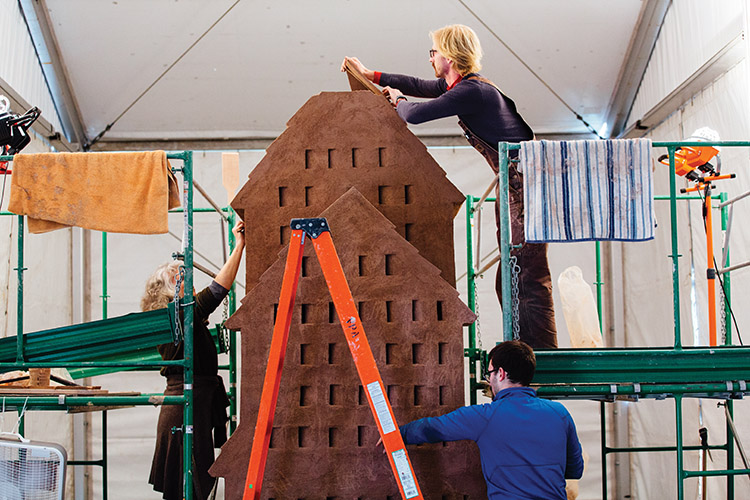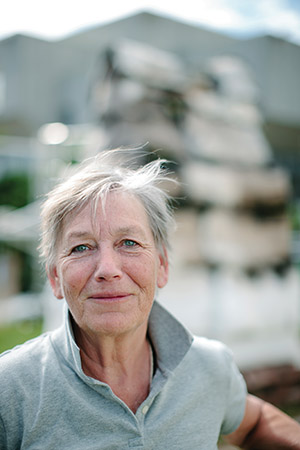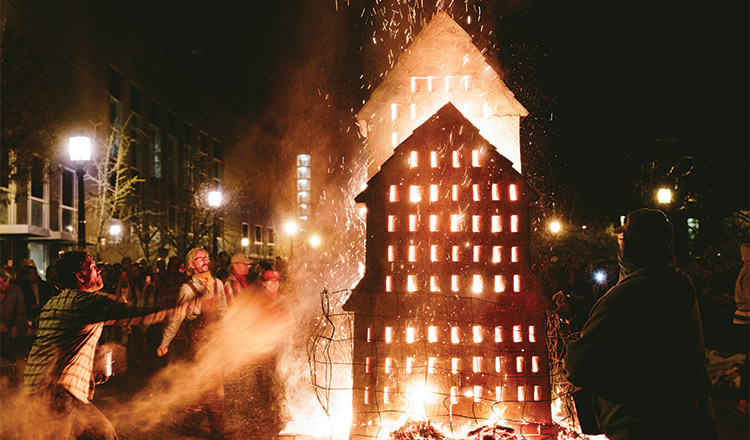The last ‘Fire Sculpture’ by the late Nina Hole ignites campus
The sun is setting on the lawn next to Pao Hall. Spectators surround a burning, house-like sculpture created as its own kiln — the last Fire Sculpture designed by the late, world-renowned ceramic artist Nina Hole.
An orange luminescence reflects on the faces in the crowd as they watch Hole’s “fire-mates” feed the blaze inside the twelve-foot tall clay sculpture that is built and fired on location. Helpers tie scarves over their mouths as they confront the embers. The heat forms a comforting wall of warmth.
During previous weeks, assistants crafted hook-shaped clay building blocks that were placed atop a brick base. A white refractory fabric swaddles the 6,000-pound sculpture to hold in the heat that can peak at over 2,012-degrees Fahrenheit. The fabric is made from spun silica similar to that used on the exterior of NASA rocket ships. The “space blanket” interplays art with science and, serendipitously links Danish artist Nina Hole with the campus known for its space mavericks.
Hole passed away last February at age 75, two months before her Fire Sculpture was set aflame for a multi-day burn and a final firing on April 16 outside the Pao Hall of Visual and Performing Arts. The looming earthen inferno resembles a building with hundreds of tiny, inviting windows.
“The architecture of houses is very inspiring,” Hole said in 2015. “In my eyes, they are sculptures at their best. The house as a metaphor means one’s own body. In fact, it means your own ego.”

Hole designed “ego houses” and then burned the egos to create large-scale ceramic art that rose, phoenix-like, from the flames. Hole, herself, was a soft-spoken phoenix, humble with no trace of ego.
“There was an incredible warmth in her,” says Craig Hartenberger, Hole’s assistant continuing her work. “She was a famous artist, well-known and respected over the world, but she had no ego. She would share anything with anyone, encourage anyone, talk to anyone.”
Renata Cassiano leads the project in Hole’s absence. She met and married Hartenberger when they worked on Hole’s 2012 sculpture located in North Carolina, and aptly named, “The Meeting Place.”
“Nina was a very generous person,” says Cassiano. “She shared what she was making and how she was making it. Sometimes in ceramics, people don’t want to share techniques. She taught us to always be grateful and curious about our work, the world, and people. That shaped who I am, not only as an artist, but as a person, too.”
Hole built her first Fire Sculpture in 1994 and then traveled the world pioneering large-scale ceramic pieces built in a few weeks and fired in place.
Purdue’s Lonsford Committee worked with Hole for nearly two years to acquire the sculpture proposed by Sigrid Zahner, associate professor of fine arts. The Florence H. Lonsford (LA’36) endowment supports the acquisition of art objects at Purdue. Lonsford was a painter, sculptor, and printmaker. The words she wrote of her 1930s-era Purdue experience resonate today in Hole’s Fire Sculpture: “There was wonderment about our futures and what they were to hold. We looked to Purdue for inspiration.”
After the space fabric is removed from the sculpture using long sticks and the molten-hot edifice is unveiled, a mixture of sawdust and salt is thrown upon the clay to control cooling and add color. Sparks fly heavenward.
The next day, the creators return to the cooled sculpture and reveal its name. The last sculpture designed by Nina Hole and permanently displayed at Purdue is named “Repose” — a state of rest, sleep, or tranquility; situated or grounded in a particular place.
Nina Hole
Ceramic Artist
1941–2016
Nina Hole was born in Denmark and lived there in a coastal village with her husband, architect, Lawrence Minske. She trained at the Art and Craft School, Copenhagen, and Fredonia State College, New York. America was where Hole could become the artist she wanted to be. She created about two-dozen, large-scale Fire Sculptures internationally for more than 20 years, perfecting a spectacular outdoor firing technique, transforming raw clay into a finished piece entirely in place. She integrated kiln and sculpture into a single structure, incorporating a firebox beneath the work.

The element of risk was an important aspect of Hole’s creative work. She enlisted a number of assistants — “fire-mates”—and believed the process and communal experience of working with a team as important as the final art piece. Hole was a role model for women in the field. Hole helped found Denmark’s CLAY Museum of Ceramic Art and Guldagergaard International Ceramics Research Center.
A MYTHICAL BIRD that never dies, the phoenix flies far ahead to the front, always scanning the landscape and distant space. It represents our capacity for vision, for collecting sensory information about our environment and the event unfolding within it. The phoenix, with its great beauty, creates intense excitement and deathless inspiration.
—The Feng Shui Handbook

